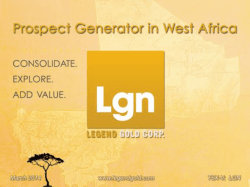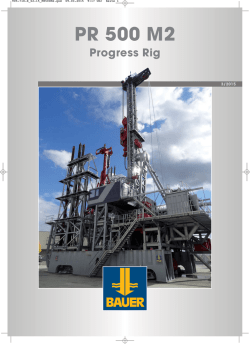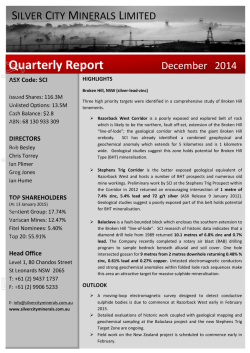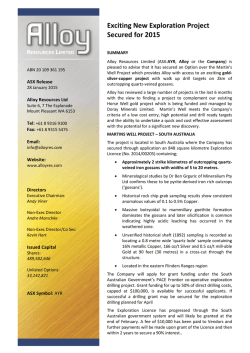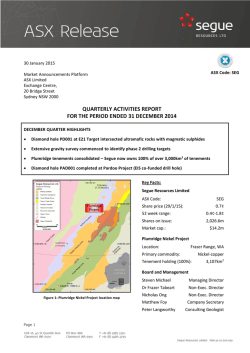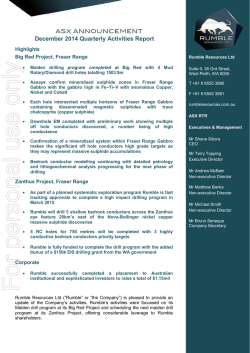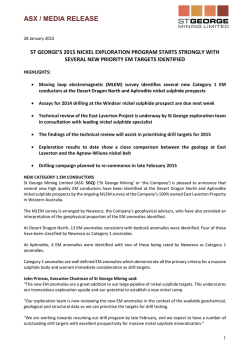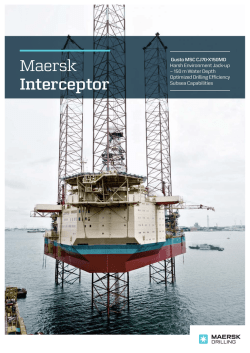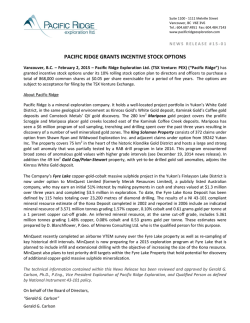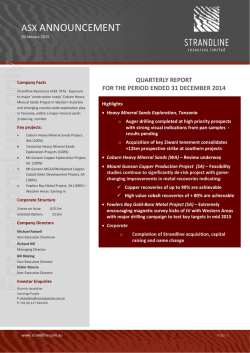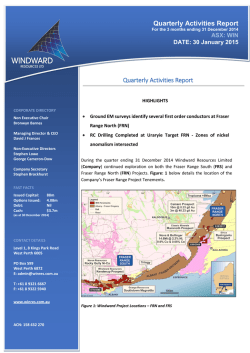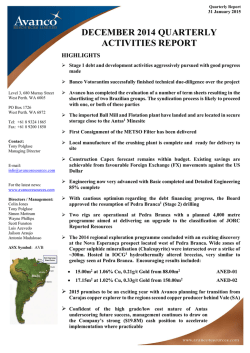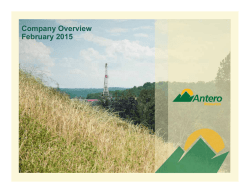
Talisman Mining
Doolgunna Copper-Gold Projects 28 January 2015 COMPANY SNAPSHOT Drilling and Exploration Update Board of Directors Sandfire resumes exploration activities for 2015 at Alan Senior Non-Executive Chairman Springfield as part of a major campaign to define potential drill targets Gary Lethridge Managing Director Brian Dawes Non-Executive Director Karen Gadsby Non-Executive Director Highlights Extensive exploration programs continuing at Talisman’s Springfield Project under the $15M farm-in JV with Sandfire Resources. Key recent and upcoming activities by Sandfire Resources include: Contact Details o over 16,700 metres of geochemical Aircore drilling completed in the December Quarter and over 21,000 metres in calendar 2014 over the DeGrussa, Monty, Central and Southern Volcanic corridors; 6 Centro Avenue Subiaco, Western Australia, 6008 Telephone: +61 8 9380 4230 o high-powered Fixed Loop and down-hole Electromagnetic surveys across the prospective volcanic rock sequences; Facsimile: +61 8 9382 8200 Email: [email protected] o low-level multi-element analysis of historical drill samples to determine areas with possible DeGrussa-like lithochemical signatures for further follow-up. Website: www.talismanmining.com.au Capital Structure Sandfire Resources resumed AC drilling in early January, adding further to the already extensive datasets currently being collected and assessed. These recent and ongoing exploration activities are anticipated to assist Sandfire Resources in generating robust DeGrussa-style exploration targets at Springfield for potential drill testing during 2015. Shares on Issue: 131,538,627 (TLM) Options on Issue: 6,250,000 (Unlisted) ASX: TLM Talisman Mining Ltd ABN 71 079 536 495 6 Centro Avenue, Subiaco, Western Australia 6008 www.talismanmining.com.au Doolgunna- Exploration Update Talisman Mining Limited (ASX: TLM – “Talisman” or “the Company” is pleased to provide an update on drilling and exploration activities within its Doolgunna Copper-Gold Projects in Western Australia, where its joint venture partner Sandfire Resources NL (ASX: SFR) continues to progress a major exploration program and has recently re-commenced drilling. Overview Talisman’s Doolgunna Copper-Gold Projects comprise the Springfield, Halloween and Halloween West Projects (see Figure 1), which abut Sandfire Resources’ (ASX: SFR) DeGrussa-Doolgunna Project. Sandfire is funding active exploration programs across these projects as part of a joint venture farm-in signed in December 2013. Under this agreement Sandfire has the right to earn up to a 70% interest in Talisman’s Doolgunna Projects by spending $15 million on exploration over five-and-a-half years. Preliminary observations from the initial phases of exploration at the Springfield Project have delivered significant geological encouragement, confirming that the Project contains interpreted extensions of the volcanic rock package which hosts the DeGrussa VMS deposits. Figure 1: Talisman Mining Ltd Springfield, Halloween and Halloween West JV Project Locations Doolgunna- Exploration Update Drilling Activities Extensive programs of detailed Aircore (AC) drilling were undertaken by Sandfire during the December 2014 Quarter across the Homer (DeGrussa) and Southern Volcanic trends with a total of 278 holes drilled for 16,780m. A total of 21,099m of AC drilling was completed by Sandfire for the 2014 calendar year at the Springfield Project (see Figure 2). Geological units encountered in drilling included sediments, mafic volcanic sediments, dolerites and basalts, which are interpreted to be consistent with the geology encountered along the DeGrussa corridor on Sandfire’s tenements. Sandfire re-commenced its AC drilling program at Springfield in early January 2015 and plans to continue drilling activities through the March Quarter (see Figure 2). Final assay results for the geochemical AC drilling are pending and a detailed interpretation of the geochemical and geological information will begin in the first half of 2015 once all results have been returned, validated and integrated with historical Talisman drill-hole data. Homer AC Geochemistry Programme Degrussa Mine Central Volcanics Regional AC Geochemistry Programme Monty Regional AC Geochemistry Programme Southern Volcanics Regional AC Geochemistry Programme Figure 2: Springfield Project interpreted geology showing regional Aircore drill holes; completed holes shown in green and holes to be drilled in March 2015 Quarter in magenta. To assist with future modelling and interpretation, 1,137 pulp samples have been re-assayed using lowdetection multi-element Laser Ablation ICP-MS analysis techniques to identify potential Degrussa-like lithochemical signatures. In undertaking this work, samples were taken from the fresh rock interface in historical Talisman drilling as well as samples from the recent Sandfire drill holes. Analysis and interpretation of the data will continue in the first half of 2015 as the final assays are received and subsequently integrated / processed with the historical lithochemical data. Doolgunna- Exploration Update Geophysical Activities High-powered down-hole DHEM (down-hole electromagnetic surveying) and FLEM (fixed-loop electromagnetic surveying) are key tools in VHMS exploration, and these geophysical techniques have proven to be successful in the DeGrussa environment. Accordingly, they are being extensively deployed by Sandfire across the prospective stratigraphy at the Springfield Project. At the end of December 2014, the first two phases of planned FLEM surveys, consisting of a total of 24 highpowered FLEM loops (each 1,200m by 1,000m), had been completed over the northern extension of the DeGrussa Formation at Homer, as well as the Central Volcanic Corridor and the Monty Prospect (see Figure 3) The third and fourth phases of the regional FLEM program re-commenced in early January 2015 and are planned to comprise 25 loops encompassing a large proportion of the Southern mafic volcanic succession (see Figure 3). This work program is ongoing and may be completed in the March Quarter 2015. Degrussa Mine Completed FLEM (Phase 1 & 2) Outstanding FLEM (Phase 3 & 4) Figure 3: Springfield Project interpreted geology with Fixed Loop Electromagnetic (FLEM) survey locations. Completed surveys are shown in blue, with planned / current surveys shown as a black outline. In addition to the ground EM surveys, a total of 20 RC and diamond drill holes were re-surveyed during the December 2014 Quarter using the latest high-powered (100A) Fluxgate down-hole EM technology. Both the ground FLEM and DHEM data are currently being assessed by geophysical consultants Newexco and will be integrated with the new geochemical and geological data in order to identify DeGrussa-style copper-gold targets for drilling. Doolgunna- Exploration Update Looking Forward Ongoing work by Sandfire at the Springfield Project in the first half of the 2015 calendar year is designed to continue to allow for holistic geological, geophysical and geochemical targeting across the entire prospective Narracoota mafic volcanic sequences at Springfield. Planned upcoming programmes include: Completion of first-pass regional aircore programmes across the prospective mafic volcanics; Continued high-powered FLEM surveying with Phases 3 & 4 scheduled to be completed in the March Quarter 2015; Detailed validation and interpretation of the exploration data, incorporating geochemical AC drilling, DHEM, FLEM, and low-level multi-element analysis; Commencement of in-fill (400m x 400m) FLEM surveys over regional EM anomalies; and Commencement of follow-up diamond drilling of EM targets identified by the FLEM surveys. It is anticipated that the integration and assessment of the final data from these multi-disciplined exploration campaigns will assist Sandfire in potentially generating robust DeGrussa-style exploration targets at Springfield. ENDS For further information, please contact: Gary Lethridge – Managing Director on +61 8 9380 4230 For media inquiries, please contact: Nicholas Read – Read Corporate on +61 419 929 046 Competent Persons’ Statement Information in this ASX release that relates to Exploration Results and Mineral Resources is based on information compiled by Mr Graham Leaver, who is a member of the Australian Institute of Geoscientists. Mr Leaver is a full time employee of Talisman Mining Ltd and has sufficient experience which is relevant to the style of mineralisation and types of deposit under consideration and to the activities undertaken to qualify as a Competent Person as defined in the 2012 Edition of the “Australian Code for Reporting of Mineral Resources and Ore Reserves”. Mr Leaver consents to the inclusion in this report of the matters based on information in the form and context in which it appear. Doolgunna- Exploration Update Appendix 1 - JORC TABLE 1 Section 1 Sampling Techniques and Data (Criteria in this section apply to all succeeding sections) Criteria Sampling techniques Drilling techniques Drill sample recovery JORC Code explanation Nature and quality of sampling (e.g. cut channels, random chips, or specific specialised industry standard measurement tools appropriate to the minerals under investigation, such as down-hole gamma sondes, or handheld XRF instruments, etc). These examples should not be taken as limiting the broad meaning of sampling. Include reference to measures taken to ensure sample representivity and the appropriate calibration of any measurement tools or systems used. Aspects of the determination of mineralisation that are Material to the Public Report. In cases where ‘industry standard’ work has been done this would be relatively simple (e.g. ‘reverse circulation drilling was used to obtain 1 m samples from which 3 kg was pulverised to produce a 30 g charge for fire assay’). In other cases more explanation may be required, such as where there is coarse gold that has inherent sampling problems. Unusual commodities or mineralisation types (e.g. submarine nodules) may warrant disclosure of detailed information. Commentary Drill type (e.g. core, reverse circulation, open-hole hammer, rotary air blast, auger, Bangka, sonic, etc) and details (e.g. core diameter, triple or standard tube, depth of diamond tails, facesampling bit or other type, whether core is oriented and if so, by what method, etc). Method of recording and assessing core and chip sample recoveries and results assessed. Measures taken to maximise sample recovery and ensure representative nature of the samples. Whether a relationship exists between sample recovery and grade and whether sample bias may have occurred due to preferential loss/gain of fine/coarse material. Sampling methods employed by Sandfire include half-core sampling of NQ2 core from diamond drilling (DD) and Air Core (AC) samples are collected from spear samples for both composite and single metre samples. Sampling is guided by Sandfire DeGrussa protocols and QAQC procedures as per industry standard. DD sample size reduction is completed through a Jaques jaw crusher to -10mm and all samples Boyd crushed to -4mm and pulverised via LM2 to nominal 90% passing -75µm. RC and AC sample size reduction is completed through a Boyd crusher to -10mm and pulverised via LM5 to nominal -75µm. Pulp size checks are completed. Pulp samples are fused into a glass bead by the combination of 0.4g of assay sample plus 9.0g flux XRF analysis. A 40g and 0.15g assays charges are used for FA and mixed acid digest respectively. Sandfire core samples are routinely sampled for SG determination. Sandfire diamond drilling is completed by DD rig with a core size of NQ2. Sandfire AC drilling is completed with a blade bit. All surface drill collars are surveyed using RTK GPS. Holes are inclined at varying angles for optimal ore zone intersection from the drilling position. All core where possible is oriented using a Reflex ACT II RD orientation tool with stated accuracy of +/-1% in the range 0 to 88°. Sandfire core is meter marked and orientated to check against the driller’s blocks, ensuring that all core loss is taken into account. Diamond core recovery is logged and captured into the database with weighted average core recoveries of approximately 99%. Sample quality is routinely captured in the database. AC sample recovery is noted and recorded should sample return be diminished or wet. This information is recorded digitally in the Sandfire database. AC rig cyclone is regularly cleaned by drilling contractors to minimise sample smearing. Samples are routinely weighed and captured into a central secured database. No sample recovery issues have impacted on potential sample bias. Doolgunna- Exploration Update Logging Sub-sampling techniques and sample preparation Whether core and chip samples have been geologically and geotechnically logged to a level of detail to support appropriate Mineral Resource estimation, mining studies and metallurgical studies. Whether logging is qualitative or quantitative in nature. Core (or costean, channel, etc) photography. The total length and percentage of the relevant intersections logged. If core, whether cut or sawn and whether quarter, half or all core taken. If non-core, whether riffled, tube sampled, rotary split, etc and whether sampled wet or dry. For all sample types, the nature, quality and appropriateness of the sample preparation technique. Quality control procedures adopted for all sub-sampling stages to maximise representivity of samples. Measures taken to ensure that the sampling is representative of the in situ material collected, including for instance results for field duplicate/secondhalf sampling. Whether sample sizes are appropriate to the grain size of the material being sampled. Quality of assay data and laboratory tests The nature, quality and appropriateness of the assaying and laboratory procedures used and whether the technique is considered partial or total. For geophysical tools, spectrometers, handheld XRF instruments, etc, the parameters used in determining the analysis including instrument make and model, reading times, calibrations factors applied and their derivation, etc. Nature of quality control procedures adopted (e.g. standards, blanks, duplicates, external laboratory checks) and whether acceptable levels of accuracy (i.e. lack of bias) and precision have been established. Sandfire geological logging is completed for all holes and representative across the ore body. The lithology, alteration, and structural characteristics of core are logged directly to a digital format following standard procedures and using Sandfire DeGrussa geological codes. Data is imported into the central database after validation in LogChief™. Logging is both qualitative and quantitative depending on field being logged. All cores are digitally photographed and stored. Sandfire diamond core orientation is completed where possible and all are marked prior to sampling. Half core samples are produced using Almonte Core Saw. Samples are weighed and recorded. Sandfire AC samples consist of 5m composite spear samples produced from 1m drilling and weights average approximately 3kg. In certain locations after composite samples are received additional sampling at 1m intervals may be completed. Sandfire sample preparation at UltraTrace in Perth involves the original samples being dried at 80° for up to 24 hours and weighed. DD Samples are then crushed through Jaques crusher to nominal -10mm. Second stage crushing uses Boyd crusher to nominal -4mm.. Pulverising is completed using LM5 mill to 90% passing 75%µm. Sandfire has protocols that cover auditing of sample preparation at the laboratories and the collection and assessment of data to ensure accurate steps in producing representative samples for the analytical process. Key performance indices include contamination index of 90% (that is 90% blanks pass); Crush Size index of P95-10mm; Grind Size index of P90-75µm and Check Samples returning at worse 20% precision at 95% confidence interval and bias of 5% or better. Duplicate analysis is routinely completed. The sample size is appropriate for the VHMS and Gold mineralisation styles. Sandfire samples submitted to Ultra Trace in Perth are assayed using Mixed 4 Acid Digest (MAD) 0.3g charge and MAD Hotbox 0.15g charge methods with ICPOES or ICPMS. The samples are digested and refluxed with a mixture of acids including Hydrofluoric, Nitric, Hydrochloric and Perchloric acids and conducted for multi elements including Cu, Pb, Zn, Ag, As, Fe, S, Sb, Bi, Mo, Re, Mn, Co, Cd, Cr, Ni, Se, Te, Ti, Zr, V, Sn, W and Ba. The MAD Hotbox method is an extended digest method that approaches a total digest for many elements however some refractory minerals are not completely attacked. The elements S, Cu, Zn, Co, Fe, Ca, Mg, Mn, Ni, Cr, Ti, K, Na, V are determined by ICPOES, and Ag, Pb, As, Sb, Bi, Cd, Se, Te, Mo, Re, Zr, Ba, Sn, W are determined by ICPMS. Samples are analysed for Au, Pd and Pt by firing a 40g of sample with ICP AES/MS finish. Lower sample weights are employed where samples have very high S contents. This is a classical FA process and results in total separation of Au, Pt and Pd in the samples. Sandfire DeGrussa QAQC protocol is considered industry standard with standard reference material (SRM) submitted on regular basis with routine samples. Sandfire insert SRMs and blanks at a minimum of 5% frequency rate. A minimum of 2% of assays are routinely resubmitted as Check Assays and Check Samples through blind submittals to external and primary laboratories respectively. Adhoc umpire checks are completed annually. Doolgunna- Exploration Update The verification of significant intersections by either independent or alternative company personnel. The use of twinned holes. Documentation of primary data, data entry procedures, data verification, data storage (physical and electronic) protocols. Discuss any adjustment to assay data. Location of data points Accuracy and quality of surveys used to locate drill holes (collar and down- hole surveys), trenches, mine workings and other locations used in Mineral Resource estimation. Specification of the grid system used. Quality and adequacy of topographic control. Data spacing and distribution Data spacing for reporting of Exploration Results. Whether the data spacing and distribution is sufficient to establish the degree of geological and grade continuity appropriate for the Mineral Resource and Ore Reserve estimation procedure(s) and classifications applied. Whether sample compositing has been applied. Orientation of data in relation to geological structure Whether the orientation of sampling achieves unbiased sampling of possible structures and the extent to which this is known, considering the deposit type. If the relationship between the drilling orientation and the orientation of key mineralised structures is considered to have introduced a sampling bias, this should be assessed and reported if material. Sandfire exploration holes are oriented to achieve high angles of intersection. Diamond drilling is used as required to determine structural orientations in regional programs. Sample security The measures taken to ensure sample security. All samples are prepared onsite under the supervision of Sandfire Geological staff. Sandfire samples are transported to the Perth Ultra Trace laboratory by Toll IPEC or Nexus transport companies in sealed bulka bags, or to the onsite laboratory by company personnel. The laboratories receipt received samples against the sample dispatch documents and issues a reconciliation report for every sample batch. Verification of sampling and assaying Audits or reviews The results of any audits or reviews of sampling techniques and data. No significant drilling intersections are reported in this report. No twinned holes are being drilled as part of this programme. Primary data is captured on field tough book laptops using Logchief™ Software. The software has validation routines and data is then imported into a secure central database. The primary data is always kept and is never replaced by adjusted or interpreted data. Sandfire DeGrussa Survey team undertakes survey works under the guidelines of best industry practice. Downhole survey completed by electronic multishot systems. MGA94 Zone 50 grid coordinate system is used. Sandfire AC drilling across the Homer / Degrussa trend is spaced on a nominal 250m x 100m pattern, and a nominal 800m x 100m pattern across the Southern Volcanics trend. No drilling results are reported. The Sandfire sampling techniques and data collection processes are of industry standard and have been subjected to multiple internal and external reviews. Doolgunna- Exploration Update Section 2 Reporting of Exploration Results Criteria JORC Code explanation Commentary Mineral tenement and land tenure status Diamond drilling by Farm-in Partner Sandfire is on tenement E52/2313. AC drilling by Sandfire is on tenements E52/2313 and E52/2282. These leases are part of Talisman’s 100% owned Springfield Project, 150km north-east of Meekatharra, WA. These tenements fall within the Department of Conservation-managed Doolgunna pastoral lease. All Springfield tenements are current and in good standing. Exploration work at Springfield completed prior to Talisman’s tenure included geochemical soil and rock chip sampling combined with geological mapping. Some targeted RC drilling was completed over gold and diamond targets. Talisman’s Doolgunna Project lies within the Proterozoicaged Bryah rift basin enclosed between the Archaean Marymia Inlier to the north and the Proterozoic Yerrida basin to the south. The principal exploration targets at the Doolgunna Projects are Volcanogenic Massive Sulphide (VMS) deposits located with the Proterozoic Bryah Basin of Western Australia. Type, reference name/number, location and ownership including agreements or material issues with third parties such as joint ventures, partnerships, overriding royalties, native title interests, historical sites, wilderness or national park and environmental settings. The security of the tenure held at the time of reporting along with any known impediments to obtaining a licence to operate in the area. Exploration done by other parties Acknowledgment and appraisal of exploration by other parties. Geology Deposit type, geological setting and style of mineralisation. Drill hole Information o o o o o A summary of all information material to the understanding of the exploration results including a tabulation of the following information for all Material drill holes: easting and northing of the drill hole collar elevation or RL (Reduced Level – elevation above sea level in metres) of the drill hole collar dip and azimuth of the hole down hole length and interception depth hole length. If the exclusion of this information is justified on the basis that the information is not Material and this exclusion does not detract from the understanding of the report, the Competent Person should clearly explain why this is the case. Detailed AC drill hole information is not included with this report. General locations of the AC drilling is indicated in Figure 2. No drilling results are being reported and it is not considered to be material to this report. Drill hole information will be included in future reports when appropriate. Doolgunna- Exploration Update Data aggregation methods Relationship between mineralisation widths and intercept lengths Diagrams In reporting Exploration Results, weighting averaging techniques, maximum and/or minimum grade truncations (e.g. cutting of high grades) and cut-off grades are usually Material and should be stated. Where aggregate intercepts incorporate short lengths of high grade results and longer lengths of low grade results, the procedure used for such aggregation should be stated and some typical examples of such aggregations should be shown in detail. The assumptions used for any reporting of metal equivalent values should be clearly stated. These relationships are particularly important in the reporting of Exploration Results. If the geometry of the mineralisation with respect to the drill-hole angle is known, its nature should be reported. If it is not known and only the down hole lengths are reported, there should be a clear statement to this effect (e.g. ‘down hole length, true width not known’). Appropriate maps and sections (with scales) and tabulations of intercepts should be included for any significant discovery being reported These should include, but not be limited to a plan view of drill hole collar locations and appropriate sectional views. Balanced reporting Where comprehensive reporting of all Exploration Results is not practicable, representative reporting of both low and high grades and/or widths should be practiced to avoid misleading reporting of Exploration Results. Other substantive exploration data Other exploration data, if meaningful and material, should be reported including (but not limited to): geological observations; geophysical survey results; geochemical survey results; bulk samples – size and method of treatment; metallurgical test results; bulk density, groundwater, geotechnical and rock characteristics; potential deleterious or contaminating substances. No drilling intersections reported. No drilling intersections reported. Appropriate maps with scale are included within the body of the accompanying document. No drilling intersections reported. The accompanying document is considered to represent a balanced report. Other exploration data collected is not considered as material to this document at this stage. Further data collection will be reviewed and reported when considered material. Doolgunna- Exploration Update Further work The nature and scale of planned further work (e.g. tests for lateral extensions or depth extensions or large-scale step-out drilling). Diagrams clearly highlighting the areas of possible extensions, including the main geological interpretations and future drilling areas, provided this information is not commercially sensitive. Further work is contingent on the outcomes of current drilling and ground electromagnetic surveys.
© Copyright 2026
